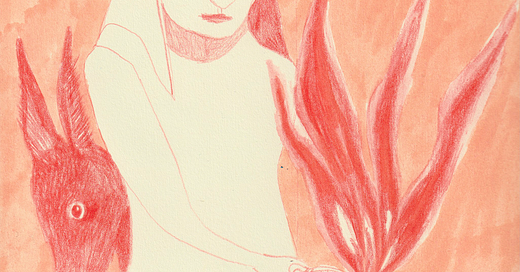Março/March
texto de Ana Rita Fernandes e desenhos de Débora Figueiredo/ written by Ana Rita Fernandes and drawings by Débora Figueiredo
M A R Ç O
Março é um mês de começos.
O Hemisfério Norte sai do estupor do Inverno, acorda, boceja, espreguiça-se.
*
Das figuras do Cristianismo, José é a minha preferida.
José tem uma função vital na História do Cristianismo: sem ele o Cristianismo, simplesmente, não existia. Ao aceitar casar com Maria, mulher mais jovem do que ele e grávida de ninguém, salva-a a ela e à Criança da morte certa. Este é o Pai, o que cria, o que cuida, o que protege. É dele que Jesus herda a profissão.
É uma imagem masculina da fertilidade, mas não de uma potência eréctil, não há aqui muita simbologia fálica para além do “bordão do homem velho que volta a florir”. Mas florescem açucenas que são puras e castas. José não é um reprodutor, um garanhão, mas um Pai.
*
Originalmente Saturno era um deus agrícola. Vela pela agricultura, abundância e pela continuidade genealógica, o que não deixa de ser curioso para um deus com o hábito de comer os próprios filhos. Só depois é que o hábito de devorar os próprios filhos o torna no Pai Tempo. Casa com a própria Natureza, Cibele, e a primogénita, Vesta, é a deusa romana do Fogo Sagrado, semelhante e diferente da sua contraparte grega, Héstia.
O Fogo Sagrado que Vesta vela é o da Cidade, dos Templos e do Lar. Pede ao irmão para permanecer virgem para poder velar por tudo e todos.
Pode parecer estranho que o mês primaveril por excelência seja dedicado a uma deusa casta, mas Março já foi o primeiro mês do ano, o de reacender e vivificar os Fogos.
*
Março é um mês de começos – do ano, da vida –, de guardiões e de novos fogos.
March is a month of beginnings.
The Northern Hemisphere emerges from the stupor of Winter, wakes up, yawns, stretches.
*
Among the figures of Christianity, Joseph is my favourite.
Joseph plays a vital role in the history of Christianity: without him, Christianity simply would not exist. By agreeing to marry Mary, a younger woman than him and pregnant by no one, he saves both her and the Child from certain death. He is the Father, the one who creates, who cares, who protects. It is from him that Jesus inherits the profession.
He is a masculine image of fertility, but not of an erectile potency; there is not much phallic symbolism here beyond the “staff of the old man that blooms again.” But lilies bloom, which are pure and chaste. Joseph is not a reproducer, a stallion, but a Father.
*
Originally, Saturn was an agricultural deity. He watched over agriculture, abundance, and genealogical continuity, which is curious for a god with the habit of eating his own children. Only later does the habit of devouring his own children turn him into Father Time. He marries Nature itself, Cybele, and the firstborn, Vesta, is the Roman goddess of the Sacred Fire, similar yet different from her Greek counterpart, Hestia.
The Sacred Fire that Vesta watches over is that of the City, the Temples, and the Home. She asks her brother to remain a virgin so she can watch over everything and everyone.
It may seem strange that the quintessential spring month is dedicated to a chaste goddess, but March was once the first month of the year, the time to reignite and invigorate the Fires.
*
March is a month of beginnings – of the year, of life –, of guardians and new fires.




